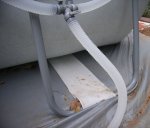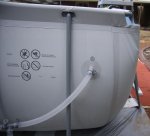Hi I am a newbie to owning a pool, we bought a Bestway rectangular pool and have had it up for just over a week. Now, one of the legs is sinking and we're resigned to the draining and correcting. I have a couple of questions - what to do with all that water - there must be somewhere to store it, is it safe in our rainwater tanks?
Also, how do we correct the problem without having to dig out the whole area? All the other legs are fine, it's just one that is sinking. I stupidly didn't join this forum before putting it up otherwise I'd have know that adding dirt to the area wasn't good enough. The pool bottom is beautifully smooth with no stones and the water has been perfect too - thanks to the advice learned on here.
Also, how do we correct the problem without having to dig out the whole area? All the other legs are fine, it's just one that is sinking. I stupidly didn't join this forum before putting it up otherwise I'd have know that adding dirt to the area wasn't good enough. The pool bottom is beautifully smooth with no stones and the water has been perfect too - thanks to the advice learned on here.






 Sorry to hear you are having problems. I know nothing about AGPs but can keep you company until someone who does can respond.
Sorry to hear you are having problems. I know nothing about AGPs but can keep you company until someone who does can respond.
